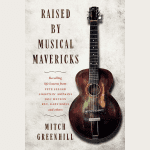Bowie in Books
On Jan. 8, 2016, David Bowie celebrated his 69th birthday — though quietly — and also released his new album, Blackstar, to wide critical acclaim. Bowie’s demonstrated his passionate musical genius by traversing musical borders, shifting sounds, forever trying out the new and stretching the boundaries of jazz, rock, pop, electronica, and soul.
As we know — from a reading list Bowie compiled a few years ago and from other stories that have emerged since the singer’s death — he was also an inveterate reader whose tastes ranged very widely. He listed Jessica Mitford’s The American Way of Death and Greil Marcus’ Mystery Train, Anne Petry’s The Street and Martin Amis’ Money.
It’s of course very tempting to ponder the composition of that list, searching for clues about the similar themes running through these books. It’s also tempting to start up a No Depression reading club and to use Bowie’s list as a reading guide. But, the former trades in idle speculation while the latter exists simply as an ideal.
There are a number of books about Bowie, though, with which fans of Bowie will already be familiar and with which they may disagree to some extent or another, but which are instructive and informative for listeners who wish to become more acquainted with the singer and his work.
Nicholas Pegg’s The Complete David Bowie (Titan, 2011) contains an A-Z analysis of Bowie’s work and detailed datelines of every portion his life, from his participation in the Bromley Scouts’ Summer Camp in 1958 to his skiffle performance when he was 11. The book includes detailed analysis of every album and song, as well as set lists for all of Bowie’s performances and a guide to his performances on stage and screen.
Paolo Hewitt’s Bowie: Album by Album (Insight, 2013) lives up to its title, providing behind-the-scenes information for each album, from Bowie’s eponymous debut in 1967 to 2003’s Reality. Hewitt richly illustrates his book with rare photos of Bowie in the studio and on tour with other musicians. Meanwhile, In Strange Fascination: David Bowie: the Definitive Story (Virgin, 2010), David Buckley tells Bowie’s story in a series of photographs from Bowie’s collection, including pictures of the singer’s wedding to his wife, Iman.
Wendy Leigh’s David Bowie: The Biography (Gallery, 2014) offers an intimate look at Bowie’s rise to fame. The book features some never-before-seen photographs and Leigh chronicles, in often pedestrian prose, his relationships with artists such as John Lennon, Mick Jagger, Marianne Faithfull, Tina Turner, and Nina Simone, among others.
Finally, in David Bowie: Starman (Little, Brown, 2011), Paul Trynka draws upon more than 250 new interviews with friends of Bowie, as well as from previously published interviews with Bowie. The former Mojo editor affectionately chronicles the life and music of Bowie from his childhood and youth to the high points of his career, his recent heart attack, and his almost total disappearance from the music scene. Bowie emerges from Trynka’s portrait as a less-than-consummate musician and more as an ambitious individual who knew how to get exactly what he wanted from those around him. From the growling guitars of “Suffragette City” and the driving dance beats of “Young Americans” to the stuttering syncopation of “Fame” and the Beatles-like riffs of “Changes,” Bowie, in Trynka’s hands, is a man who has never settled for the predictable. The lack of any new interviews with Bowie, however, gives the biography the feel of a hagiography.
As in Bowie’s own reading list, there’s a title here to satisfy every kind of interest in him. More importantly, the breadth and variety of these titles illustrate the depth of Bowie’s mystique as well as an enduring admiration for Bowie’s gifts. While these books — and there are others — give us the man behind the music, they also drive us to pick and listen to Bowie’s music and the gifts he’s left us.




